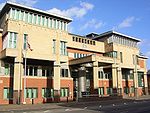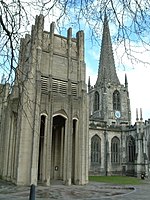Kelham Island is one of Sheffield's eleven designated Quarters. Formerly an industrial area, the island itself was created by the building of a goit, or mill race, fed from the River Don to serve the water wheels powering the workshops of the areas' industrial heyday. The quarter was named after the island, however, the boundaries extend beyond the physical island created by the river and goit.
The Quarter is roughly diamond in shape, and is bordered by Shalesmoor and Gibraltar Street to the south-west; Corporation Street to the south-east; Mowbray Street, Harvest Lane and Neepsend Lane to the north-east, and Ball Street and Cornish Street to the north-west. The Cornish Place Works sit just outside this quarter, to the north-west. Green Lane and Alma Street form the main spine roads of the area. The Green Lane Works (Grade II* listed) and the Brooklyn Works (Grade II listed) are both important industrial heritage sites. A great deal of urban regeneration is evident in this area, as residential and social uses are mixed into this former industrial area.
The area is home to an industrial museum, the Kelham Island Museum, including the famous River Don Engine. The Chimney House for events and occasions and five pubs: the Kelham Island Tavern (twice CAMRA National Pub of the Year), the Fat Cat, The Wellington, the Ship Inn and The Milestone. It is also host to the Kelham Island Brewery (brewers of Pale Rider, amongst others). The area is the only area in Sheffield with its own dedicated app This Is Kelham that supports independent businesses, regeneration and aids the funding of community projects. The Quarter housed one of Sheffield's last traditional hand-made scissor makers, Ernest Wright and Son Limited, until their relocation to premises closer to the city centre in 2011.
 Continue reading on Wikipedia
Continue reading on Wikipedia 









